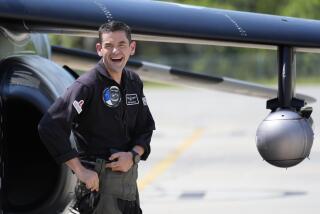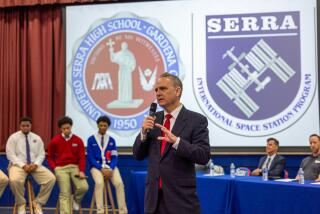Aiming high: Students at USC attempt to launch rocket into space
In the northern Nevada desert, student engineers from the University of Southern California’s Rocket Lab in Los Angeles say they are trying to make history Friday evening by sending a student-built rocket into space.
By the time the rocket motor burns out in about 13 seconds, it will have gone from zero to six times the speed of sound, or 4,500 miles per hour. If they succeed in getting the aptly named “Traveler” to reach the 62-mile mark, these young engineers will be the first group of students to successfully launch a rocket into space, representing the culmination of several years of work since USC alum Ian Whittinghill dreamed up the idea as a freshman in 2003.
Over nearly a decade, several generations of students have devoted countless hours to the goal, sometimes 40 or 50 per week, outside of their classwork. For an engineer with an already-heavy course load, that’s no small commitment.
Whittinghill, the son of the founder of Whittinghill Aerospace LLC, spent much of his youth immersed in rocket science. When he came to USC, he began to see how all the classes were teaching key bits of information that could be used to design and build such a craft on campus.
“It was the perfect fusion of all these disciplines … a natural fit,” he said.
Whittinghill persuaded some professors, including Dan Erwin, now chairman of the department of astronautical engineering, to submit a proposal for funding and space.
“I was asking for what I thought were outlandish things,” Whittinghill said. To his surprise, his fledgling Rocket Lab got $160,000 in initial funding and some dedicated workspace.
When freshman David Reese joined him the next year, Whittinghill had done much of the bureaucratic legwork. Reese jumped right in – he also had a longstanding love of engineering, and had even started making rocket propellant in the 10th grade under supervision of a high school teacher.
After spending months outfitting a lab, the new and growing team built its first rocket in 2006 in two weeks, just before the end of the school year.
“I had never built a rocket that quickly and so I was terrified,” said Reese, now a doctoral student in aeronautics and astronautics at Purdue University. “When things go wrong with rockets they tend to go wrong in a really bad way – all at once.”
But the launch was successful, and the team began building better and lighter rockets, culminating in the Traveler rocket being launched in Friday’s test.
Whether or not it’s successful, launching the rocket is “partly a relief,” senior Jordan Noone, the team’s head of operations, said Thursday as he and a group of students drove a trailer full of launch equipment up to the launch site two hours north of Reno. “The group has had this looming over their heads for the last three years.”
Noone is part of the younger generations of the Rocket Lab who followed in Whittinghill and Reese’s footsteps. The group’s success as waves of engineering students have come and gone has relied on the commitment of older students to train the younger ones, holding seminars to fill them in.
Still, there’s no substitution for hands-on work beyond the textbook equations, Noone said. And it can be a bruising experience – literally.
“We had some adventures the other day with Traveler,” Noone said. As they tried to make two tightly fitted parts knock into place, “hammers start coming out and things start getting hit together, and all of a sudden, someone gets a bruise.”
That practical experience is a huge boon to Rocket Lab students, who are often actively courted by commercial space and aeronautics companies once they graduate, Whittinghill said.
But one of the most valuable aspects of the student-run operation is that it allows participants to fail, with minimal consequences – and learn from those mistakes, he added.
“Honestly, you end up learning so much more from a failure than you do from a success,” Whittinghill said. “We built this culture that was very failure-tolerant, and I think it’s a good deal of what’s responsible for … this test today.”







